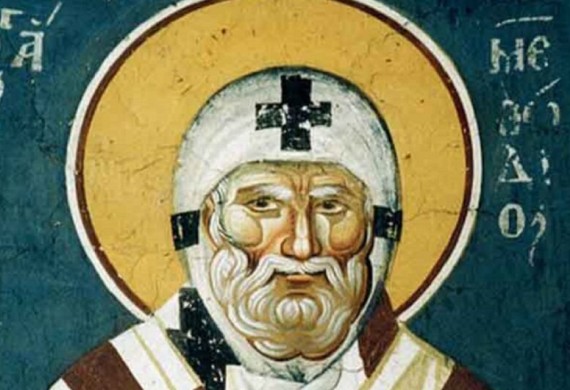Saint Methodius, who lived during the time of the iconoclast emperor Theophilos (829 – 842 AD), was born in Syracuse, Sicily, in a noble family. After finishing his studies in his hometown, he went to Constantinople to find a job appropriate to his education and abilities.
However, he was persuaded by a monk and he retired to the monastery of Hinolakko to become a monk. He was distinguished for his asceticism, high education, sincere piety and pure heroic spirit. He became an admirer and friend of Saint Theodore the Studite and travelled with him to many places, helping him in his struggle to restore the veneration of the holy icons.
At first, the emperor Theophilos tried to associate with Saint Methodius, through treatments while showing him a special appreciation. He, however, while honoring the emperor, did not cease to remain faithful to the Orthodox faith, to criticize with courage and defiance the imperial decrees against the holy icons and to educate many of the imperial environment in the divine teachings of Orthodoxy. However, due to his excessive zeal for the holy icons, he was arrested, flogged in a horrible way and he was thrown, along with two robbers, into a pit on the island of Saint Andrew in the region of Akrita, as a prisoner, where he remained for seven years (but not in the temple of Saint John the Forerunner on the island of Antigone, as is mentioned in the tradition).
After the death of Theophilos, his successor, Theodora, recalled Saint Methodius to Constantinople on behalf of Saint Joannicius the Great of Olympus, and by a joint vote of the clergy and the people, he ascended to the Patriarchal throne on February 12 of 842 AD.
The first concern of the Holy Patriarch was to settle the issue of the holy icons. For this purpose, on February 19 of 842 AD, he formed a Synod in which he presided. There, the holy icons were restored and the leaders of iconoclasm where excommunicated. The event of the restoration of the icons was celebrated with a great litany throughout the city, with the participation of all the bishops and clergymen in Constantinople, the empress Theodora, her underaged son emperor Michael and the entirety of the people of Constantinople. Since then, it was established that this triumph of Orthodoxy should be solemnly celebrated on the First Sunday of the Great Lent, the Sunday of Orthodoxy.
It’s worth mentioning that the Studites, who were his friends and allies right up until he became Patriarch, while they should have been satisfied with the triumph of Orthodoxy, suddenly they became his most bitter enemies. The reasons for this enmity are many -one is that Saint Methodius was elected Patriarch, while four Studite co-candidates were ignored.
After that, Saint Methodius transported to Constantinople with great honor the holy relics of Saints Nikiforos, Patriarch of Constantinople and Theodore the Studite who died in exile. The transportation took place on January 26 of 844 AD.
He spent the rest of his life healing the wounds that were the result of the Iconoclasm, living ascetically, despite his advanced age, distinguishing himself in the gift of calligraphy and in the transcription of many books of Psalms.
Saint Methodius fell asleep in peace in 847 AD, and the Church, rewarding his struggles and life, ranked him among its Confessors. In front of his tomb, in the temple of the Holy Apostles, the emperor was coming on the second day of Easter, he was praying and lit candles.
Translated from the Greek article:
https://www.hristospanagia.gr/14-%CE%B9%CE%BF%CF%85%CE%BD%CE%AF%CE%BF%CF%85-%CF%83%CF%85%CE%BD%CE%B1%CE%BE%CE%B1%CF%81%CE%B9%CF%83%CF%84%CE%AE%CF%82-%CE%B5%CE%BB%CE%B9%CF%83%CE%B1%CE%AF%CE%BF%CF%85-%CF%80%CF%81%CE%BF%CF%86%CE%AE/
Saint Methodius the Confessor, Patriarch of Constantinople

